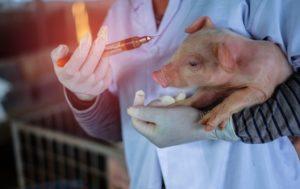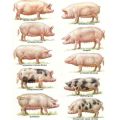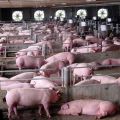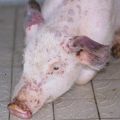Symptoms and diagnosis of trichinosis in pigs, treatment methods and prevention
Trichinosis is an invasive disease of many animals and humans. It is caused by Trichinella - round small worms related to nematodes, parasitizing only inside the host's body. Trichinosis of domestic pigs is especially dangerous. If sanitary standards are neglected when slaughtering animals, processing their meat, the larvae of the parasite can enter the human body. Trichinosis is dangerous because there are still no reliable treatments for farm animals.
How the parasite develops
The development of the pathogen occurs inside the body in several stages.
Intestinal phase
The parasite enters the stomach of a pig or other animal in the form of live encapsulated larvae along with meat. There, the capsules are destroyed by gastric juice, the larvae end up in the duodenum. They stay there for 30-40 hours. During this time, they form into adults capable of reproduction. Fertilization occurs. Males die after it.
Fertilized females with their head end are introduced between tubular outgrowths and villi of the intestinal epithelium. The developmental cycle from egg to larva takes place within 7 days. A week later, the females give birth to live larvae. After that, the next phase of development begins.
One individual can produce about 2000 larvae. Trichinella that laid larvae remain alive for up to 8 weeks, after which they die and are excreted along with feces.
Migration phase
The migration routes of larvae are still the subject of scientific controversy. It is believed that they first enter the lymph. From it, the pathogen migrates to the lymph nodes, from them to the vena cava. Then, with the bloodstream, they are carried throughout the pig's body. The size of migratory larvae does not exceed 110 microns in length and 5-6 microns in diameter. Their movement takes place until the moment they fall into the tissues of the skeletal muscles.
Muscular phase
Inside the striated muscle, the larvae fall under the cell walls. The muscle larva has the following dimensions:
- males are equal in length to 1.1 and 0.06 millimeters in diameter;
- females are 1.3 and 0.06 millimeters in length in diameter.
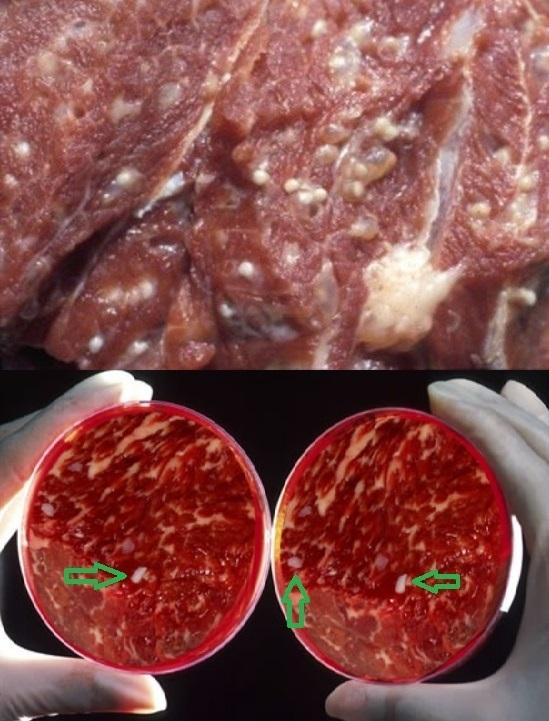
In the larvae, the main organs are formed during the muscular stage. They increase significantly in size. The length of females is 3-4, and males are 2.2 millimeters. The larvae twist into a spiral, and a capsule appears around them. Her education takes 3 to 9 weeks. It will take another 16 months for calcification.In skeletal muscle, the encapsulated larvae can remain alive for up to 25 years. In the external environment, this period is six months.
Trichinosis symptoms
In case of accidental infection of pigs, the clinical picture is erased. In about 30% of cases, symptoms are not pronounced. With intense intentional infection in animals, damage to the intestines and blood vessels is observed. The disease is characterized by the following symptoms:
- refusal to eat;
- lethargic behavior;
- weight loss;
- exhaustion;
- convulsions;
- swelling;
- vomiting;
- diarrhea;
- breathing disorder;
- allergic manifestations in the form of a rash.
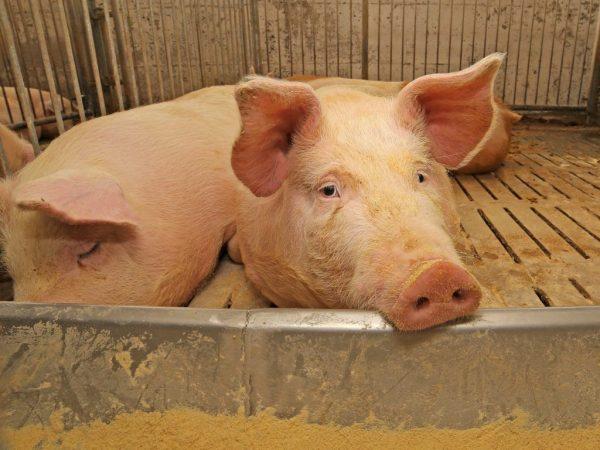
During life, a disease in a domestic pig can be diagnosed by a combination of symptoms, analysis of tissues taken from the auricles or by means of a special enzyme immunoassay. Wild boar meat is most often subjected to posthumous examination.
Disease diagnosis rules
To confirm the well-being of pig herds, vital diagnostics of animals is of great importance. ELISA is of great importance in this regard. This is a special enzyme immunoassay. It is carried out to animals of any age, starting from the full 3 months of life, 3-4 weeks after infection. Identified sick individuals are excluded from the feeding group. The disadvantage of such a study is considered to be 92-97% accuracy. Therefore, ELISA does not exclude further study of pig carcasses. To confirm the results and more accurate diagnostics, a veterinary examination is carried out in several ways. To do this, use:
- Compressor trichinelloscopy, for which 24 slices are made from muscle tissue, crush it, and then study under a trichinelloscope or under a microscope.
- Digestion of muscles in artificial gastric juice. A very accurate method of postmortem diagnosis. The selected meat is ground, poured with a mixture of water, hydrochloric acid, pepsin. Put in a thermostat for 5 hours. Then the liquid is drained, the sediment is examined.
- Postmortem diagnosis is performed with a complete dissection of the intestine. The adult parasite is most often found in the small intestine. The intestinal section is cut and filled with water together with the contents. After several washes, examine the precipitate under a microscope.
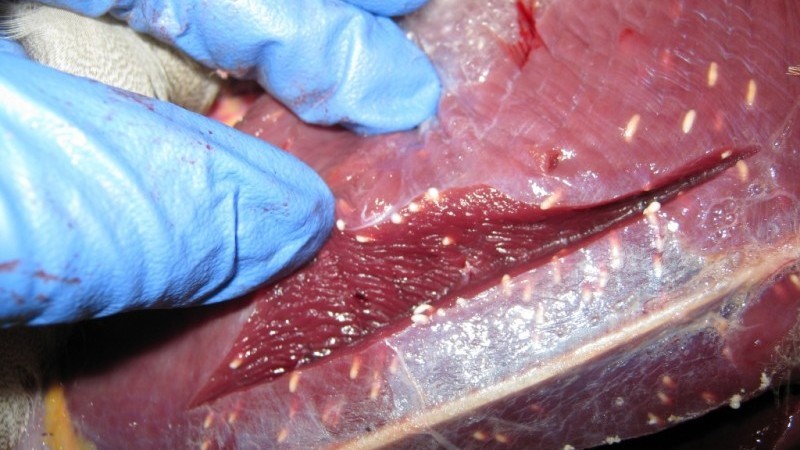
These methods allow the detection of Trichinella in raw meat carcasses, ready-to-eat meat products. Currently, IGF is becoming popular - an enzyme immunoassay that is carried out on special polymer membranes.
Porcine trichinosis treatment methods
Modern veterinary pharmacology has not developed effective drugs that can be used to treat pigs for trichinosis. The following drugs can be used:
- Thiabendazole;
- Mebendazole;
- Albendazole;
- Parbendazole.
These funds are effective only against adults, larvae until the stage of capsule formation. There is information about the treatment with cadmium oxide, chlorophos. In most cases, animals infected with Trichinella are euthanized. Carcasses are disposed of.

Why are parasites dangerous?
Trichinella larvae, enclosed in capsules, are dangerous because they are resistant to high, low temperatures, and other destructive processes. When boiling a piece of meat weighing about 1 kg, the destruction of the larvae can be achieved only after two and a half hours. The freezing process at -25 degrees must be carried out for at least 4-5 days. In decaying remains, the larvae remain alive for 4-6 months.
Parasites are very dangerous to humans. Poorly cooked, uncooked meat from infected pigs can become a source of infection for him. Full recovery from trichinosis can occur after 6-12 months of complex therapy. In severe cases, it can cause various serious disturbances in the work of the heart, central nervous system, which causes the death of the patient.
Prevention measures
For the prevention of trichinosis, it is necessary to protect the places where pigs are kept from the penetration of rodents. Rats, mice are carriers of this disease. Solid walls, floors, and the absence of holes in them will become an obstacle for them.
It is advisable to bury the carcasses of animals caught in the hunt to a depth of at least one meter, in places inaccessible for tearing by pigs, dogs, and other animals. Do not feed pigs with raw slaughter residues of domestic animals, fur animals. Observe the rules for slaughtering livestock in personal and farm households. To prevent human infection, you should not buy pork that has not passed veterinary examination. Hunting meat must be delivered to the nearest laboratory for inspection. It is important to remember that any disease is easier to prevent than to cure.

